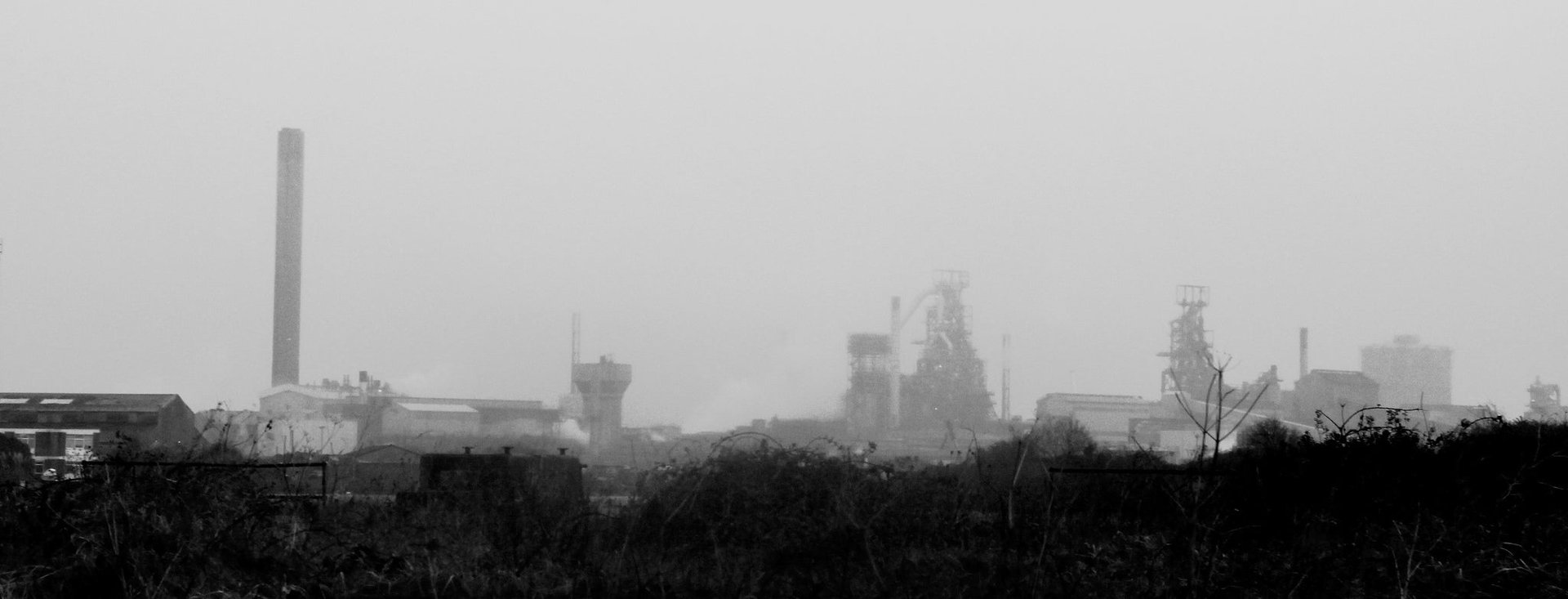In an era of changing work, how will your job define who you are?
This is episode three of the series “The ID Question,” from How We Get To Next. Read episode one and episode two.


This is episode three of the series “The ID Question,” from How We Get To Next. Read episode one and episode two.
The steelworks in Port Talbot, Wales, once among the largest in Europe, are the tallest buildings for miles in any direction. 50 years ago, they loomed over the town as a symbol of prosperity; today they represent the loss of that success. In the 1960s, nearly 20,000 of a population of 50,000 worked there; now, only 4,000 do, roughly one in ten residents.
“[The steel industry] was deeply entwined with the social life,” says Bleddyn Penny. He grew up in a similar Welsh community, and went on to study the post-World War II social history of Port Talbot’s steelworks for his PhD. “In the 1950s or ’60s, [steel companies] wanted to portray themselves as philanthropic- or socially-minded organizations. So they built sports clubs in Port Talbot, which are still there today. They had their own rugby teams—sporting and social activities either directly built or patronized by the steel works. It was quite a blurring of lines between civic and industrial life of Port Talbot.”
The clubhouse and the rugby club are still there, but you can see the neglect. “In the ’50s and ’60s the steel industry was in a very buoyant condition and they had a lot of money,” Penny says. “They had the means to financially support a lot of these institutions. But by the time you get to the ’70s, everyone is trying to increase the shrinking profit margin, and things like the works clubs were of course the first to get cut.”

There are plenty of places like Port Talbot around the world, towns where large companies have historically dominated their employees’ lives, or even where whole communities were planned and built by companies themselves for their workers. Everything down to the water supply can be, directly or indirectly, affected by the actions of one company.
After decades of decline, the Port Talbot steelworks are up for sale and may close completely if a buyer cannot be found. If they do close, it will likely lead to an entire generation lost to unemployment and poverty. For the town itself, it’s not just an economic loss, but a question of identity: “When you have this economic reliance or generational continuity, it engenders a kind of cultural identity,” Penny says. “Port Talbot still sees itself as an industrial town, as a working class town.” The closure of the steelworks could mean losing what is left of Port Talbot’s soul.
In London, just a few hours’ drive from Port Talbot, 20-year-old Daniel lives a very different kind of working life to that of a generational steel worker. As a cyclist for the food-delivery company Deliveroo, Daniel (whose name has been changed) is a so-called “gig economy” worker, someone who works irregular hours for irregular pay—a job with a lot of flexibility but little security. He loves that flexibility, as he balances work, study, and social life: “[It’s] what really drew me into the job,” he says. “It seemed almost too good to be true.”
People working for similar gig economy companies—like Uber, TaskRabbit, or Instacart—often feel the same way about their jobs. These companies claim they “empower” people to work on a schedule that works for them; the trade-off is that income is uneven and lower-paid than a lot of the jobs that they replaced in the overall economy, and some companies discourage—or outright ban—their employees from organizing or joining established unions.
There have been many ways to organize the relationship between workers and work throughout human history. Today, what’s left of the Port Talbot-style company town and the gig economy sit at opposite ends of an employer-employee relationship spectrum. In places like Port Talbot, work and social life were rooted in a single company in a specific place; for the gig worker, all that flexibility comes with a lack of any institutional support at all.
So far, this series has focused on identity as something that people entrust governments with—for better or for worse—from ID cards like Aadhaar to leak-prone digital databases. But other institutions play equally pivotal roles in defining identity, and our employers top that list. What will our working lives look like in the coming decades—and as work evolves, how will it affect our identities?
The “gigs” of the gig economy are mostly short-term rather than permanent. This work overlaps with “freelancing,” “contracting,” and “temping”—all of which mean different things depending on industry or location—but the gig economy has some new peculiarities compared to older categories of work: the majority of the sector is technology companies who use apps to connect people who need labor with people who want to sell their labor. Gig economy workers often fall into a kind of grey area within existing employment laws around the world, with little to no protections—and these companies are waging a PR battle against the negative criticism they attract from a broad coalition of civil society organizations and governments.
A recent McKinsey report divides independent workers in the gig economy into four groups: “free agents,” “casual earners,” “reluctants,” and “financially-strapped.” Free agents and casual earners willingly do (and report liking) these jobs, either as a primary or supplemental income source. Reluctants and the financially-strapped participate in the gig economy out of necessity.
Daniel is one of these casual earners, making deliveries on the side to help pay for his education. But he’s not thrilled with the work: “I wouldn’t do this for a living, as it wouldn’t be very intellectually stimulating,” he says. Like those stuck in unemployment, there are psychological costs to having such a precarious working existence—and it’s lonely, too. Daniel found little social support or friendship from his colleagues. “My only interactions with other riders after training ended up being a nod of acknowledgement when we pass each other on the streets,” he says. “And if I ever got to speak with them, they always seemed to be overly-talkative—as if they’ve been lacking human connection.”
Amy Garland, chief marketing officer of the US-based KaZING, a gig economy app that focuses on services like cleaning or repairs, says that gig economy workers who like their jobs rate individual freedom—like control over their hours—as one of the biggest sources of job satisfaction. But this can run counter to job security. “I think the top concerns of workers in this sector are about consistency and job security,” she told me. “While flexibility, freedom, and independence are something that everybody values tremendously, it requires a bit of a balancing act.”
The things gig workers value—specifically individual freedom and flexibility—are the opposite of what the people living in towns like Port Talbot have historically valued. In Port Talbot, the broad sphere of the workplace is more of a community, or even a family: generations of people working the same jobs, alongside generations of their neighbors.
The steelworks of Port Talbot are still economically important, and they support a number of local businesses. But as a social and cultural center, they don’t command life in the way they once did. “The social aspect that the works used to sustain—the sports clubs and hobby clubs—aren’t there anymore,” says Penny. The things that used to go beyond the transactional nature of the employer-employee relationship have been slowly killed off.
“For many people, it was more than earning money, it was social,” says Penny. “They talked a lot about the glory days of working men’s clubs and pub culture, but most of the socializing was done in the workplace. They were truly ‘workmates’ because they spent so much time together at work, and then when they lost their jobs they were deprived of quite an important social fabric.”
For more than a century, the residents of Port Talbot had a central well of collective identity. This came not just from working and living alongside each other, but from the social and economic life of their community being dominated by a single large industry. Modern jobs, especially those in which interaction is almost wholly digital, might on the surface look like they can’t offer that same sense of communal identity—they both can and cannot. Lots of cities—particularly in higher-income countries—have clusters of remote workers, working alongside each other on different things, but still providing community and social outlets.
That isn’t the same as what came before, though, and that change is clearly unsatisfying to many—especially since this new clustering tends to happen in cities, leaving smaller towns behind. As one mode of job satisfaction fades and another emerges, what are we losing—and what could we gain?
Some argue that while many newer tech companies are creating new jobs, they aren’t “real jobs”—the kind that come with good benefits and predictable hours. This was far from the only kind of work in the 20th century, but it was what work in places like Port Talbot looked like—and even if you didn’t have a good job in a company town, it was what you might aspire to. The disappearance of that way of work is a major source anxiety around the world—and it’s not immediately clear how some of the new work identities, like those forming around the gig economy, can offer an easy replacement.
A future of fractious, uncertain employment isn’t just an issue confined to Europe and the US: lower-income countries in Africa, Asia, and South America are also experiencing a similar shift. A 2016 study by the Oxford Internet Institute found that a lack of bargaining power was one of the four main concerns for workers in new digital economies in sub-Saharan Africa and south-east Asia, for example. And while most governments attempt to address unemployment, like creating programs to retrain people with new skills, that is largely only found in higher-income countries. Most of the world’s population is experiencing temporary employment not as an aberration from the norm, but as just what modern, developed economies look like. That’s going to require a very different conversation about the links between personal identity and labor than in a context of an industry-dominated world disintegrating.
Work is, by nature, dynamic, and issues like globalization, automation, and worker displacement are just the latest manifestations of that dynamism. But that also means our ideas about work and the self are inherently unstable—every intimate, personalized relationship rooted in work is only ever built on a shaky foundation. For millions of workers, work now means anxiety-inducing uncertainty.
Regardless of whether someone in Port Talbot worked for the steel industry directly or indirectly, it was at the heart of the place. Replacing lost jobs isn’t just about wages and employment; it’s about filling those gaps in individual and collective identities. “When the last plant finally went, there was a kind of collective dislocation, an identity lost, a sense of, ‘What is this town here for?’” Penny says. “They have to create a new narrative about the town…a search for that one thing that justifies their existence. But what is their story going to be?”
This article was originally published on How We Get To Next, under a CC BY-SA 4.0 license. Read more about republishing How We Get To Next articles. Sign up to the How We Get To Next newsletter here.